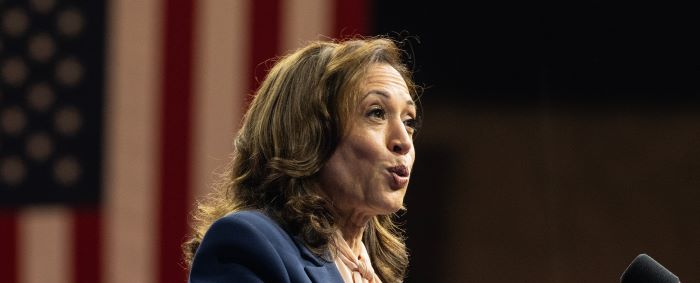Trump v. Harris: Changes to Regulatory Landscape


This blog explores potential shifts in the regulatory landscape following the November 2024 U.S. presidential election.
As Ethics & Compliance (E&C) and Human Resources (HR) professionals, anticipating regulatory changes is crucial for effective corporate governance and risk management. Our analysis examines two hypothetical scenarios: a Republican victory led by Donald Trump, and a Democratic win under Kamala Harris, each with their respective party gaining control of Congress. It’s important to note that while significant policy changes often require long-term legislative action, the most immediate impacts are likely to stem from shifting priorities within executive branch agencies and new political appointments, such as in the Department of Justice.
What sets this analysis apart is the use of machine learning to conduct a dispassionate and nonpartisan analysis of each candidate. We employed an AI tool, to analyze candidates’ platforms, past actions, and leadership styles and develop composite profiles to predict potential policy directions. This approach allows us to offer unique insights while maintaining objectivity. See the bottom of this report for a detailed Methodology explanation.
We invite E&C and HR professionals to use this analysis as a starting point for strategic planning, keeping in mind that long-term legislative changes may be limited due to potential congressional gridlock and recent trends favoring obstruction over compromise. Our goal is to provide you with a comprehensive overview of possible regulatory shifts, empowering you to proactively consider their impact on your roles and responsibilities.


First Scenario: Trump Wins
A second Trump presidency coupled with Republican control of Congress could lead to significant changes in the regulatory landscape, particularly in areas such as immigration, labor laws, and corporate governance.
Immigration Policy
The Trump campaign has pledged to implement what it calls “the largest domestic deportation operation in American history.” This aggressive approach to immigration enforcement could have significant implications for workforce stability and HR strategies across various industries. Trump has also indicated he would seek to reduce legal immigration, which could significantly impact talent acquisition of skilled workers.1 2
Stricter immigration enforcement
- Mass Deportation Policies: Trump has proposed invoking the 1798 Alien Enemies Act to bypass due process in deporting suspected members of drug cartels or criminal gangs. While the legality of such an approach would likely face court challenges, even the attempt to implement such policies could create uncertainty and disruption in the labor market. Industries heavily reliant on immigrant labor, such as agriculture, construction, and hospitality, could face significant workforce disruptions. HR professionals in these sectors may need to develop contingency plans for potential labor shortages and increased turnover.3 4 5
- Impact on Workforce Availability and Supply Chain Disruptions: The construction industry, which employs approximately 20% immigrant labor, could face particular challenges. Similar impacts could be felt in service industries. E&C professionals may need to assess and mitigate risks associated with potential disruptions to supply chains and project timeliness due to labor shortages.
Overhaul of legal immigration system
- Reductions in Work Visas and Green Cards: Proposals to limit legal immigration pathways could affect various visa programs, including H-1B visas for skilled workers. This could negatively impact sectors reliant on foreign talent such as in technology, higher education, and healthcare.6 HR professionals in these sectors may need to develop new strategies for talent attraction and retention in a more restrictive immigration environment.7
Labor and Employment
Despite attempts in 2024 to appeal to pro-union voters, Trump’s campaign, colleagues, and the actions of his first administration have shown he favors deregulation of worker protections by opposing rules about wages and overtime, appointing anti-labor judges, and weakening workers’ collective bargaining rights.8 9
Significant rollback of worker protections
- Potential Repeal or Modification of Pro-Labor Regulations: Trump has expressed intentions to reduce the power and independence of federal agencies. This could result in the weakening or repeal of various worker protection regulations. For instance, there might be attempts to roll back Obama-era rules on overtime pay, joint employer standards, or workplace safety regulations. HR professionals may need to revisit and potentially revise policies related to subjects.3 8
Weakening union power and the EEOC
- Shift in Enforcement Priorities and Interpretation of Labor Laws: The National Labor Relations Board (NLRB) under a Trump administration might prioritize employer rights over employee protections, potentially reversing Obama and Biden-era decisions on issues like joint employer standards or employee handbooks. The Equal Employment Opportunity Commission (EEOC) could also see a shift in focus, potentially de-emphasizing systemic discrimination investigations in favor of individual complaint resolution.10 The EEOC’s emphasis on proactive measures to prevent discrimination could be reduced. However, if workers have limited outlet or recourse through the EEOC, they might take their case on social media, opening organizations up to reputational harm. To mitigate this risk, E&C and HR teams may seek to open need issue intake channels to alleviate feelings of helplessness from workers.
Environmental Regulations
Trump has regularly made discussions about the energy sector a staple of his 2024 campaign with calls for increased production of fossil fuels while disparaging the use of renewable energy systems. He has stated he intends to withdraw the United States from the 2015 Paris Climate Agreement and weaken federal legislation promoting sustainability.3 11
Dismantling of climate change initiatives
- Potential Repeal of Inflation Reduction Act (IRA) and CHIPS Act Provisions: Trump has pledged to press Congress to gut the Inflation Reduction Act and rescind all unspent funds under the legislation. This could significantly impact clean energy initiatives and related tax credits, especially in the manufacturing, energy, construction, and agriculture industries. Without the tax credit incentives, organizations may have their E&C teams deprioritize ESG goals.12
- Implications for Corporate Sustainability Programs and ESG Reporting: Companies may seek to reevaluate their sustainability strategies. ESG reporting requirements could be relaxed and E&C teams would no longer be expected to conduct ESG-related training.13 However, it should be noted that in the age of consumer activism, companies will still face pressure from investors and consumers to maintain robust sustainability practices.
Deregulation of energy sector
- Impact on Businesses’ Long-Term Energy Strategies and Compliance Programs: Trump has promised to ease restrictions on fossil fuel production. This might create a more complex regulatory landscape for E&C and legal professionals in the energy and manufacturing sector as reduced federal oversight will leave behind a patchwork of state and local regulations.14 When the first Trump Administration sought to rollback automobile emission standards, manufacturers pushed back claiming they would fall behind in development if they ignored market pressures to reduce emissions.15 Pressure from stakeholders and customers to maintain high environmental standards will not abate in spite of changes in restrictions. Therefore, E&C professionals will need to be more adaptable and proactive, balancing compliance with industry best practices, heightened public scrutiny, and the expectation of federal oversight returning under another administration.
Healthcare and Benefits
At various points during the first Trump administration, unsuccessful efforts were made by Republicans to repeal the Affordable Care Act (ACA) or remove its provisions. Many proposals put forward by Trump’s colleagues consisted of market-based solutions, believing this will increase efficiency and reduce prices.16
Attempts to repeal or significantly modify the Affordable Care Act (ACA)
- Potential impacts on employer-sponsored health plans: The elimination of the employer mandate could remove the requirement for large employers to offer affordable health coverage. Essential health benefit requirements might be removed, allowing for more flexibility in plan design. There may also be changes to dependent coverage rules, such as modifying the provision allowing children to remain on parents’ plans until age 26.17 There could be a potential elimination of ACA reporting requirements, such as Forms 1094-C and 1095-C which would require a reassessment of health plan offerings.
Push for market-based healthcare solutions
- Possible expansion of Health Savings Accounts (HSAs): Based on a previous focus during Trump’s first administration on the use of HSAs, a second administration might see increased contribution limits and expanded eligibility criteria for participation. There could also be potential allowances for using HSA funds for a broader range of health-related expenses.18 19
Corporate Governance and Financial Regulations
During his first term, Trump implemented significant deregulation across various sectors, including the financial industry. His administration eased regulations on banks and financial institutions, aiming to reduce what they viewed as burdensome oversight.3
Significant deregulation of the financial sector
- Potential rollback of Dodd-Frank provisions: Regulations on smaller and medium-sized banks may be further eased. The Volcker Rule, which restricts banks from certain investment activities, could see modifications. There might be possible changes to the Consumer Financial Protection Bureau’s authority and structure.20 21
- Implications for financial compliance programs and risk management: Organizations would need to reassess and potentially restructure existing compliance programs. There would be increased importance placed on internal risk management practices as external regulations are reduced. This could create potential for new opportunities and risks in financial product development and marketing.
Changes to SEC regulations and enforcement
- Possible reduction in disclosure requirements: Financial reporting requirements might be streamlined. There could be a potential scaling back of non-financial disclosures, such as ESG-related reporting. Possible changes to executive compensation disclosure rules may also be implemented.13 Although concern from regulators about executive conflicts of interest may relax, stakeholder pressure and the reputational losses from bad publicity would remain high.
- Impact on corporate governance practices and E&C programs: Organizations would need to balance reduced regulatory requirements with investor expectations for transparency. This might lead to potential shifts in internal control and audit practices. There would likely be a need for reassessment of whistleblower programs and internal reporting mechanisms in light of potential changes to SEC enforcement priorities.
Trade and Tariffs
Trump’s first term was marked by an aggressive approach to trade, including the implementation of tariffs on various imported goods, particularly electronics, steel, and pharmaceuticals from China. He has indicated a willingness to continue and potentially expand this approach in a second term. In addition to new trade compliance burdens, tariffs cause inflation and prices to rise; therefore, HR teams should prepare for turnover unless wages can be raised.3 22 23
Implementation of broad tariff increases
- Compliance challenges for import/export businesses: Import/export businesses would face significant challenges in adapting to a new tariff landscape. Companies (especially major importers such as technology, manufacturing, retail, and pharmaceuticals) might need to diversify their supply chains to mitigate the impact of increased tariffs. This could involve seeking new suppliers in different countries or considering reshoring options.24 Compliance teams would need to stay vigilant about rapidly changing tariff regulations and ensure accurate classification of goods to avoid penalties.
- Increased cost of living, demand for higher wages: Tariffs have long been known to cause prices to increase and this burden will be passed on to consumers. Given Trump’s suggested tariffs (and presumably retaliatory tariffs), prices from suppliers will increase within the technology, manufacturing, construction, and pharmaceutical industries. These price increases would be passed on consumers.24 25 If the tariffs are enacted, the cost of living will rise for employees and organizations will begin to suffer retention problems as the workforce seeks better wages. HR teams will have to raise wages quickly to remain competitive.
Specific tariffs on Chinese imports
- Compliance considerations for businesses with Chinese suppliers or operations: Businesses with Chinese suppliers or operations would face increased scrutiny and potential financial impacts.3 They would need to closely monitor changes in tariff rates and adjust their import strategies accordingly. This might involve implementing more sophisticated tracking systems for country of origin and tariff classification.
- Improvement of due diligence and risk management processes: Companies would likely need to improve their due diligence processes when dealing with Chinese entities which would involve more rigorous supplier screening. Risk management strategies might need to be adjusted to account for potential disruptions in Chinese supply chains or sudden changes in tariff policies.
Data Privacy and Cybersecurity
While the first Trump administration took steps to address cybersecurity concerns, particularly in critical infrastructure regarding national security matters, it did not push for comprehensive federal data privacy legislation. This approach may continue in a second term, but with special attention on protecting American intellectual property.3 26 27
Federal action on data privacy
- Implications for data management and compliance strategies: A Trump administration might pursue federal legislation that preempts state privacy laws, potentially creating a uniform national standard. While this could simplify compliance for businesses operating across multiple states, it might also result in less stringent privacy protections overall.28 In response, organizations would need to reassess their data management and privacy compliance strategies. This reassessment could involve revising data collection and processing practices, updating privacy policies, and modifying consent mechanisms to align with the new federal standards, which may be less stringent than some existing state laws.
Focus on cybersecurity as a national security issue
- Potential requirements for infrastructure protection and IT security policies : Building on directions taken during the first Trump administration, there might be increased regulations and standards for critical infrastructure protection, including mandatory cybersecurity measures for sectors such as energy, finance, and healthcare.27 There would be a need to increase investment in cybersecurity technologies, and enhance employee training programs. Compliance teams would need to incorporate these new cybersecurity requirements into their programs and demonstrate adherence to regulators and stakeholders, potentially affecting critical infrastructure sectors most significantly.
Diversity, Equity, and Inclusion (DEI) Initiatives
The Trump administration was critical of DEI initiatives, particularly in federal contracting and education. A second term might see efforts to roll back federal DEI requirements and change the interpretation of anti-discrimination laws.29 30
Rollback of federal DEI requirements
- Implications for federal contractors and corporate DEI programs: Based on efforts in the first Trump Administration, federal contractors in industries such as defense, pharmaceuticals, construction, technology, and higher education might see a significant reduction in DEI-related requirements for government contracts. This could lead to a reassessment of corporate DEI programs, potentially scaling back initiatives that were previously mandated. However, companies may need to balance any regulatory rollbacks with stakeholder expectations and the recognized benefits of diverse and inclusive workplaces.30 31
- Impact on workplace policies and training programs: Organizations may need to revise their workplace policies and training programs to align with new federal guidance. This could involve re-evaluating diversity hiring targets, modifying inclusion strategies, and potentially altering or reducing DEI-focused training programs.
Shift in civil rights enforcement
- Potential changes in interpretation of anti-discrimination laws: There could be a narrower interpretation of anti-discrimination laws, focusing more on individual instances of overt discrimination rather than systemic or unconscious biases. This shift might result in fewer investigations into patterns of discrimination and a higher burden of proof for discrimination claims.31
- Effects on compliance strategies and E&C risk assessments: During 2017, the first Trump administration’s DOJ did little with the civil rights division and a future administration could see increased politicization of the DOJ.32 33 If this happens, Ethics and Compliance professionals may need to reassess their risk management strategies. However, conventional wisdom suggests it is better in the long-term for an organization to be more compliant, more ethical, and less discriminatory even if the threshold for a violation has been lowered.
Tax Policy
The Tax Cuts and Jobs Act of 2017 (TCJA) was a signature policy of Trump’s first term. In a second term, he might seek to extend or expand these tax cuts, which included reductions in corporate and individual tax rates. Companies might benefit from continued lower corporate tax rates and potentially expanded deductions, influencing decisions on capital investments, repatriation of overseas profits, and overall financial strategies.3 34 35 36
Impact on employee compensation and benefits
- Effects on how companies structure employee compensation and benefits: Modifications to deductions for certain types of compensation might influence executive pay packages. Additionally, changes in individual tax rates could impact employees’ take-home pay and potentially influence benefit preferences.
Government Restructuring
The “Project 2025” document, while disavowed by Trump, provides insight into the thinking of the conservatives who would become bureaucrats and department heads during a second Trump administration. This document reveals a government restructuring plan which would likely cause competency losses to federal agencies.37
Potential changes to federal agencies and departments
- Implications for regulatory oversight and enforcement: Project 2025 proposes significant restructuring of federal agencies, which could lead to major shifts in regulatory oversight. For instance, the plan to divide the Centers for Disease Control and Prevention into two weaker entities could result in less stringent health-related regulations.38 In light of weakened enforcement, E&C professionals can decide whether or not to keep post-pandemic health & safety policies in place for their organizations.
- Impact on compliance reporting and interaction with government agencies: The proposed expansion of political appointees, particularly in the Department of Justice, could lead to more politically driven enforcement priorities.32 Companies might need to adjust their compliance strategies to account for potentially inconsistent or politically influenced regulatory interpretations. The plan to allow political appointees to apportion federal funds could also impact how companies interact with and report to government agencies.39
Shift towards state-level regulation
- Potential challenges for multi-state operations: As federal oversight weakens, state-level regulations may become more prominent and diverse. Companies operating across multiple states could face a more complex regulatory environment, requiring tailored compliance approaches for different jurisdictions. This would increase compliance costs and complexity, particularly for nationwide operations. E&C and HR professionals may need to develop more flexible and localized compliance strategies.


Second Scenario: Harris Wins
The potential victory of Kamala Harris, coupled with Democratic control of Congress, could usher in a period of unique regulatory change, especially for any organization taking federal funds such as from Medicare, Medicare, government contracts, research grants, and so on. The scenario below represents how the regulatory landscape might change if Harris’s policy agenda was enacted.
Labor and Employment
Harris has consistently supported strong worker protections and union rights throughout her career. Her campaign has emphasized the need for paid family leave, increased minimum wage, and stronger enforcement of labor laws.40 41
Expansion of paid family leave
- Potential impact on HR policies and procedures: Harris has championed paid family leave as a key policy priority. HR departments may need to revise existing leave policies to align with potential new federal standards. This could involve expanding the scope of leave offerings, adjusting eligibility criteria, and implementing new processes for leave requests and approvals.42 43 HR teams will need to ensure new leave policies are implemented consistently across the organization to avoid discrimination claims and managers are trained on these changes.
Strengthening of worker protections
- Possible increases in minimum wage: A Harris administration might push for a federal minimum wage increase and if this happens HR departments would need to review and potentially adjust compensation structures, particularly for entry-level positions. This could also necessitate a broader review of pay equity across the organization.40
- Enhanced enforcement of labor laws: During Harris’ tenure as the California Attorney General, she focused on issues of wage theft and the misclassification of employees as independent contractors.44 E&C professionals should prepare for potentially stricter enforcement of existing labor laws and the possible introduction of new worker protection measures.45 This might require more robust internal auditing processes, more detailed overview of metrics, and increased resources dedicated to labor law compliance.
- Labor compliance and freedom to unionize: The 2024 election has seen a rise in the importance of the pro-union “Rust Belt” states, which has given power to labor organizations (which both candidates have sought to woo). The Harris campaign has pledged to see the Public Service Freedom to Negotiate Act passed which would give all public employees in every state the freedom to form and join a union.41 46 E&C and legal teams for state, city, and county governments will need to anticipate this could change how their operations.
Focus on diversity, equity, and inclusion (DEI) initiatives
- Potential new reporting requirements: Harris has emphasized the importance of DEI in the public sector and championed causes of inclusion. If she seeks to apply this to the private sector, organizations may face new federal reporting requirements related to workforce diversity, pay equity, and inclusion initiatives. E&C and HR teams of federal contractors should prepare to collect and report on a broader range of DEI metrics.47 48 49
- Implications for workplace policies and training programs: Organizations may need to enhance their DEI policies and training programs to meet potential new federal standards on anti-discrimination policies and unconscious bias. Furthermore, HR could make themselves more appealing as a federal contractor by enacting mentorship programs to support underrepresented groups in the workplace.
Healthcare and Benefits
While Harris has moved away from supporting a single-payer healthcare system, she remains committed to strengthening and expanding the Affordable Care Act. Her proposals include measures to reduce prescription drug costs and expand access to affordable healthcare.50 51
Expansion of affordable healthcare initiatives
- Possible changes to employer-sponsored health plans: Under a Harris administration, employers may need to adapt their health plans to align with new initiatives aimed at expanding affordable healthcare. This could include adjusting plan designs to meet new coverage standards or reconsidering the competitiveness of their offerings in light of enhanced public options. HR departments might need to evaluate the cost-effectiveness of their current plans against potential new public alternatives.
- Compliance implications for HR departments: HR professionals should prepare for new compliance requirements that may accompany healthcare reforms. This could involve enhanced reporting on plan affordability and coverage, updated notice requirements to inform employees about new public healthcare options, and potential penalties for non-compliance with new standards. E&C teams in the healthcare industry may need to develop new monitoring processes to ensure adherence to evolving healthcare regulations.
Prescription drug pricing reforms
- Potential impact on employee benefits packages: Harris proposes to cap the cost of insulin at $35 and out-of-pocket expenses for prescription drugs at $2,000 for everyone. Employers may wish to restructure their pharmacy benefits to align with this cap, potentially leading to changes in plan premiums or other cost-sharing arrangements. HR departments should prepare to communicate these changes effectively to employees and adjust budgets accordingly.45 50 52
- Compliance considerations for health plan administrators: Health plan administrators will need to implement systems to track and enforce the new prescription drug cost caps. This may involve updating claims processing systems, revising formularies, and ensuring that all plan documents accurately reflect the new pricing structure. Compliance teams in both the insurance and pharmaceutical industries should be prepared for potential audits or reporting requirements to demonstrate adherence to the new pricing regulations.
- Accelerated Medicare drug price negotiations: Harris plans to speed up the process of Medicare drug price negotiations.45 53 54 E&C teams in the pharmaceutical industry should anticipate more frequent and potentially more stringent negotiation processes which means scrutiny of supply chains, due diligence reviews, and audits showing compliance with the Physician Payments Sunshine Act.
Housing and Real Estate
Addressing the housing crisis has been a key part of Harris’s campaign. The has proposed ambitious plans to increase affordable housing supply and provide assistance to first-time homebuyers.41 55 56
Implementation of housing plan
- Tax incentives for builders to create 3 million new housing units: Harris’s plan to incentivize the creation of 3 million new housing units could have significant implications for the construction industry. E&C professionals in this sector should prepare for new compliance requirements related to these tax incentives, potentially enhanced reporting on project progress, disclosures on supplier relations, workforce composition, and adherence to specific building standards that may be tied to the incentives.41 57
- Impact on construction industry and related compliance requirements: The surge in construction activity could lead to increased scrutiny of labor practices, safety standards, and environmental compliance in the industry. E&C teams may need to strengthen their monitoring and reporting processes, particularly around wage and hour compliance, workplace safety, supply chains, and environmental impact assessments.
- Investment Restrictions: The Harris campaign has stated her housing plan would be set up to prevent investors from buying up homes in bulk and prevent rent-setting data firms from price fixing. E&C teams working in property management or for real estate investment trusts (REITs) should anticipate new regulations in these areas and prepare compliance strategies accordingly.45 58
Down payment assistance program
- Compliance considerations for lenders and real estate professionals: The proposed down payment assistance program for first-time homebuyers could introduce new compliance challenges for lenders and real estate professionals.57 58 This may include detailed due diligence requirements to verify eligibility for the program, new documentation standards, and potential restrictions on fees or charges related to these assisted purchases.
- Potential new regulations to prevent fraud or abuse in the program: To safeguard the integrity of the down payment assistance program, new anti-fraud measures are likely to be implemented (especially after fraud uncovered with pandemic-relief funds).59 E&C professionals in the real estate and lending sectors should prepare for stricter verification processes, potential new reporting requirements to government agencies, and enhanced monitoring of transactions involving program funds. This could necessitate updates to existing compliance programs and training for staff involved in these transactions.
Small Businesses
Harris has emphasized the importance of supporting small businesses, particularly those owned by underrepresented groups. Her proposals include tax simplification measures and increased access to federal contracting opportunities.41 60
Implementation of small business “standard deduction”
- Potential impact on small business formation and growth: This tax simplification measure could encourage small business formation and growth.61 HR departments in larger companies may need to prepare for increased competition in talent acquisition from a potentially growing small business sector. E&C teams should also be aware of potential changes in business partnerships and supplier relationships as the small business landscape evolves.
Cross-state occupational licensing reforms
- Compliance implications for professional services firms: Reforms to make it easier for businesses to operate across state lines could lead to significant changes in compliance requirements for professional services firms.41 E&C professionals should prepare for potential standardization of licensing requirements across states, which may necessitate updates to internal policies and procedures related to professional qualifications and continuing education.
Expansion of federal contracting for small businesses
- New compliance requirements for government contractors: Harris has said her administration will aim for one-third of all federal contracting to go to small businesses. This increase in federal contracting opportunities for small businesses may come with new compliance requirements.61 E&C teams should prepare for potential changes in reporting standards, ethical guidelines, and transparency measures specific to government contracting. This may involve developing new training programs and compliance monitoring systems.
Environmental, Social, and Governance (ESG) Regulations
Throughout her career, Harris has been a strong advocate for environmental protection and action on climate change. Her administration would likely push for more stringent environmental regulations and increased corporate accountability on ESG issues.41 58 62
Increased focus on climate-related disclosures
- New reporting requirements for public companies: Given Harris’ history of supporting renewable energy sources and prosecuting oil companies, support for ESG is likely to rise (despite attempts by Republican governors to outlaw it). At the very least, increased climate-related disclosure requirements are likely. E&C professionals should prepare for more comprehensive and standardized reporting on climate risks, emissions data, and sustainability initiatives. This may involve developing new data collection processes and enhancing internal controls around environmental data.63
Expansion of social responsibility initiatives
- Potential new regulations on supply chain management: New regulations may focus on social responsibility within supply chains, potentially including labor practices, human rights, and diversity considerations.55 E&C teams should prepare for new AML/KYC requirements and potentially new reporting standards related to supply chain social responsibility.
- Impact on corporate social responsibility programs: As California’s Attorney General, Harris sued large oil companies for spreading disinformation about climate change.58 Under a Harris administration, companies may need to expand and formalize their corporate social responsibility programs to meet new regulatory expectations. This could involve developing more robust metrics for measuring social impact, enhancing stakeholder engagement processes, and integrating social responsibility considerations more deeply into business operations and decision-making processes.
Financial Regulations, Antitrust, & Corporate Governance
Harris has supported stronger oversight of the financial sector and has been critical of what she views as lax enforcement of white-collar crime. Her administration might seek to strengthen financial regulations, enhance corporate accountability, improve consumer protections, and continue the Biden administration’s strong antitrust enforcement.64 65
Strengthening of anti-corruption measures
- Potential expansion of FCPA enforcement: Under a Harris administration, there may be increased enforcement of the Foreign Corrupt Practices Act (FCPA). This would follow a trend from the Biden administration which designated “corruption” a national security issue.66 E&C professionals should prepare for more rigorous scrutiny of international business practices, potentially including expanded interpretations of what constitutes a foreign official or improper payment. This could necessitate more comprehensive screening processes for international transactions and partnerships.
- Implications for E&C training and risk assessments: Organizations may need to enhance their anti-corruption training programs, particularly for employees involved in international business. E&C teams should consider updating risk assessment methodologies to more thoroughly evaluate corruption risks in various global markets. This might involve developing more sophisticated data analytics capabilities to identify potential red flags in financial transactions and business relationships.
Enhanced whistleblower protections
- Possible changes to internal reporting mechanisms: Strengthened whistleblower protections could require companies to revamp their internal reporting systems. E&C professionals may need to review and update confidentiality measures, anti-retaliation policies, and the overall accessibility of reporting channels. This could include implementing more robust anonymous reporting options and enhancing follow-up procedures to keep whistleblowers informed of investigation progress.67
- Impact on E&C hotline management and investigations: During her legal career, Harris recognized the importance of whistleblowers and used the False Claims Act (FCA) to hold fraudsters accountable.68 E&C teams might need to adapt their hotline management and investigation processes to align with enhanced protection standards. This could involve more stringent confidentiality measures, faster response times to reports, and more comprehensive documentation of investigation steps and outcomes. Training for investigators may need to be updated to ensure compliance with new whistleblower protection standards.
Implementation of the Junk Fee Prevention Act
- Expanded fee transparency and consumer protection: The Harris administration is likely to push for the passage of the Junk Fee Prevention Act. This would require businesses across multiple sectors, including hospitality, ticketing services, telecommunications, and airlines, to be more transparent about their pricing and fees.69 E&C professionals would need to oversee significant changes in advertising practices, billing systems, and customer communication strategies to ensure compliance.
- Compliance implications for corporate governance: Organizations would need to revise their pricing structures and fee disclosures to align with new federal standards. The Federal Trade Commission (FTC) and Consumer Financial Protection Bureau (CFPB) will likely find themselves with more authority to place new requirements on businesses.58 70 E&C teams will need to update internal auditing processes to ensure fee transparency, ensure marketing guidelines and customer communications provide fee disclosures, and implementing new training programs for customer-facing staff and leadership.
Continuation of aggressive antitrust enforcement
- Intense M&A scrutiny: Building on the Biden administration’s record-setting enforcement actions, a Harris administration is expected to maintain or potentially increase the level of antitrust scrutiny. E&C professionals should anticipate equal or greater scrutiny of proposed mergers and acquisitions, potential expansion of enforcement actions beyond the tech sector,65 and particular focus on deals valued at over $1 billion.41 71 Organizations considering mergers or acquisitions will need to conduct more rigorous antitrust risk assessments before pursuing deals and prepare for longer and more complex regulatory review processes.
- Anti-competitive practices from Big Pharma: The Harris campaign has promised to penalize pharmaceutical companies who practice anti-competitive behavior by reducing the profitability of small pharmacies; which means Big Pharma’s E&C programs will need to develop new safeguards and update their risk assessments.45 50
- Extreme consolidation in the Food & Grocery Industry: Harris’ campaign has claimed large retailers in the food & grocery industry are intentionally keeping grocery prices high even though production costs have leveled off. The campaign claims consolidation within the industry is preventing prices from being lowered and only the prevention of unfair mergers & acquisitions can prevent food corporations from becoming too powerful and uncompetitive.45 58 E&C professionals will need to reevaluate their organization’s risk profile to determine if they might face litigation from an empowered FTC.
Data Privacy and Cybersecurity
Harris has expressed support for comprehensive federal data privacy legislation and has emphasized the importance of cybersecurity as a national security issue. In 2023, the Biden administration stated they wanted to see specialized organizations taking the responsibility for securing cyberspace to alleviate the burden from small businesses, local governments, and infrastructure operators. There has also been support for the use of AML/KYC provisions to prevent the abuse of cryptocurrencies in cybercrimes.55 72 73
Potential federal data privacy legislation
- Compliance implications for HR data management: The introduction of comprehensive federal data privacy legislation could significantly impact HR data management practices. HR departments may need to review and revise their data collection, storage, and usage policies to ensure compliance with new standards. This could involve implementing more robust consent mechanisms for data collection, enhancing data access controls, and developing more comprehensive data retention and deletion policies.
- Impact on E&C programs and risk assessments: E&C programs may need to expand their focus on data privacy compliance. This could involve developing new training modules on data privacy best practices, integrating privacy considerations into existing risk assessment frameworks, and implementing regular privacy impact assessments. E&C teams may also need to work more closely with IT and legal departments to ensure a coordinated approach to data privacy compliance.
Increased focus on cybersecurity regulations
- New requirements for data protection and breach reporting: A Harris administration might introduce more stringent cybersecurity regulations, potentially including mandatory security measures and stricter breach reporting requirements. As cybercrimes and intellectual property theft grows more closely linked with national security, E&C and legal teams should prepare for audits by federal law enforcement in the wake of breaches.73 Organizations may need to implement enhanced encryption standards, multi-factor authentication, and more frequent security audits. E&C and IT teams should prepare for potentially shorter timelines for breach reporting and more comprehensive disclosure requirements.
- Cracking down on ransomware attacks: The Biden administration’s cybersecurity task forces have sought to tackle ransomware security threats in both the private and public sector. Financial institutions and block chain technology firms will find themselves more scrutinized as cryptocurrencies are so often demanded as ransom. E&C teams should ensure monitoring cryptocurrency transactions are a central part of their AML/KYC strategies.72 74
Immigration Reform
Harris has advocated for comprehensive immigration reform, including a pathway to citizenship for undocumented immigrants and protections for “Dreamers.” Her administration would likely seek to expand legal immigration pathways and enhance protections for immigrant workers.50 58
Potential changes to work visa programs
- Impact on HR recruitment and retention strategies: Under a Harris administration, we might see significant changes to work visa programs, potentially including an expansion of certain visa categories or streamlined processes for high-skilled workers.55 HR departments may need to adapt their recruitment strategies to take advantage of potentially broader access to international talent. This could involve: Developing more robust international recruitment pipelines, enhancing relocation support services for international hires, and revising job descriptions and requirements to align with new visa criteria.
- Compliance considerations for employment verification: Changes to work visa programs will likely necessitate updates to employment verification processes. HR and E&C professionals should prepare for: potential changes to I-9 form requirements and processes, enhanced due diligence measures to ensure compliance with new visa regulations, and increased scrutiny of employment practices related to visa holders.
Enhanced protections for immigrant workers
- Potential new anti-discrimination measures: The Harris administration may introduce stronger protections against discrimination for immigrant workers. HR and E&C teams should anticipate expanding definitions of protected classes that may include immigration status. There may be a need for stricter enforcement of existing anti-discrimination laws as they apply to immigrant workers.55 Organizations may need specialized assessments of their hiring, promotion, and termination practices to ensure compliance with these enhanced protections.
- Implications for workplace policies and training programs: To align with enhanced protections for immigrant workers, companies may need to revise workplace policies to explicitly address the rights and protections of immigrant workers. There will be a need to develop new training modules for managers and employees on cultural sensitivity and the prevention of discrimination against immigrant workers. Additionally, E&C teams might seek to implement more robust reporting and investigation procedures for complaints related to discrimination against immigrant workers.
Conclusions
In reflection of this analysis of potential regulatory changes following the 2024 U.S. presidential election, it’s clear that both candidates would cause shifts in the regulatory landscape, albeit in markedly different directions. A Trump presidency, backed by a Republican Congress, would likely usher in an era of deregulation across multiple sectors, with a particular focus on rolling back environmental protections, labor laws, and immigration policies. This approach could potentially simplify some compliance processes, but may also create new challenges as organizations navigate reduced federal oversight. Costs for compliance may rise as reliance on the patchwork of state regulations means compliance programs must be increasingly localized.
Statistically speaking, because the United States has had more “conventional presidents” than not, Donald Trump represents an outlier.75 76 A more conventional president is most likely to return after any second Trump administration (which is what happened at the end of the first). Therefore, any deprioritization of enforcement and higher compliance costs is likely to be temporary. Playing the odds, E&C professionals and HR teams would be wise not to lower the bar for their organizations and continue to act as if stricter enforcement will return in the near future. HR professionals will need to be uniquely prepared with retention strategies as Trump’s stated policies towards immigration and tariffs are likely to create labor shortages and increase the cost of living respectively.
A Harris administration with Democratic congressional support would likely expand and clarify regulatory frameworks, particularly in areas such as worker protections, environmental policies, and social responsibility initiatives. This could lead to more expectations of compliance professionals to expand reporting obligations for organizations. As Harris comes from a legal background, she is likely to respect the legal process and recognize the need for consensus-building with the private sector when it comes to shifting the regulatory landscape. As a prediction, it is unlikely a Harris administration would cause E&C and HR teams to scramble to contend with sudden changes to long-term norms. It is also likely, given her background, Harris would use enforcement actions to pursue policy goals if she is not able to get Congress to legislate.
Regardless of the election outcome, E&C and HR professionals should always prepare for a period of some regulatory changes whenever the United States’ presidency is changing (especially if the party of the successor differs from the incumbent). The key to successfully navigating this evolving landscape will be maintaining flexibility in compliance strategies, staying informed about policy developments, and fostering a culture of adaptability within organizations. As we move forward, the ability to quickly assess and respond to new regulatory requirements will be crucial for ensuring continued compliance and capitalizing on potential opportunities that may arise from these changes.
Methodology
This article was written with the help of machine learning to provide speculative hypotheses in a dispassionate and nonpartisan way. While this article was written and sourced by humans, the tool Claude (Claude 3.5 Sonnet) was used solely to assist is speculating on how a Harris or Trump victory might impact the regulatory landscape. As of the time this article was written in early September 2024, Claude’s database had only been updated up to the events of April 2024. Therefore, Claude was provided a host of news stories from moderate/centrist with analyses from think-tanks and non-profits of various political leanings which had been published/updated since April.
Claude was told to “use the candidate’s platforms and their past actions or stances” to develop a list of changes likely to be made if the candidates and their party won the election. Claude was also instructed that it was free to use information from before April 2024 to create composites on “the candidates’ temperate, the candidates’ past behavior, who the candidates take advice from, and the types of people the candidates tend to delegate tasks” and use these composites to assist in determining how they might try to enact their policy goals.
In the creation of the composite overviews of the candidates, facts used by Claude were reviewed and sourced manually. Efforts were made to exclude use of editorials.
References
1 Debusmann Jr., Bernd and Mike Wendling. “Could Trump Really Deport One Million Immigrants?” BBC News, 16 Aug. 2024, www.bbc.com/news/articles/ce9z0lm48ngo. Accessed September 2024.
2 Haberman, Maggie et. al. “Sweeping Raids, Giant Camps and Mass Deportations: Inside Trump’s 2025 Immigration Plans.” The New York Times, 11 Nov. 2023, www.nytimes.com/2023/11/11/us/politics/trump-2025-immigration-agenda.html. Accessed September 2024.
3 Council on Foreign Relations. “Donald Trump.” Election 2024 Candidate Tracker, Council on Foreign Relations, https://www.cfr.org/election2024/candidate-tracker/donald-trump. Accessed September 2024.
4 Ebright, Katherine Yon “What Should Courts Do If a Future President Invokes the Alien Enemies Act to Deport Immigrants?” Just Security, 27 Feb. 2024, www.justsecurity.org/92690/what-should-courts-do-if-a-future-president-invokes-the-alien-enemies-act-to-deport-immigrants/. Accessed September 2024.
5 U.S. Bureau of Labor Statistics. “Foreign-Born Workers: Labor Force Characteristics — 2023.” U.S. Bureau of Labor Statistics, 18 May 2023.
6 Zielinski, Dave. “Microsoft, Google Seek Green Card Rule Change.” TechTarget, 8 Jun. 2023, www.techtarget.com/searchhrsoftware/news/366583437/Microsoft-Google-seek-green-card-rule-change. Accessed September 2024.
7 U.S. Citizenship and Immigration Services. “Employment-Based Immigration.” USCIS.gov, Accessed September 2024.
8 Economic Policy Institute. “50 ways the Trump administration has eroded workers’ rights while bolstering corporate power.” Press Releases, Economic Policy Institute, 16 Sept. 2020, https://www.epi.org/press/50-ways-the-trump-administration-has-eroded-workers-rights-while-bolstering-corporate-power/. Accessed September 2024.
9 Park, Leah J. “U.S. Department of Labor Rescinds Trump-Era Joint Employer Rule.” Paul, Weiss, Rifkind, Wharton & Garrison LLP, 20 Jul. 2021, www.paulweiss.com/practices/litigation/employment-workplace-investigations-trade-secrets/publications/us-department-of-labor-rescinds-trump-era-joint-employer-rule?id=40684. Accessed September 2024.
10 McNicholas, Celine, et al. “Unprecedented: The Trump NLRB’s Attack on Workers’ Rights.” Economic Policy Institute, 16 Oct. 2019, www.epi.org/publication/unprecedented-the-trump-nlrbs-attack-on-workers-rights/. Accessed September 2024.
11 Smith, John, and Alice Johnson. “Comparing Trump and Harris on Climate Change Policies.” The Washington Post, 15 Mar. 2024, www.washingtonpost.com/politics/interactive/2024/trump-harris-climate-change/. Accessed September 2024.
12 Bradner, Robert, et. al. “Potential Implications of a Trump Presidency for Unspent Out-Year Federal Appropriations.” Holland & Knight, 16 Jul. 2024, https://www.hklaw.com/en/insights/publications/2024/07/potential-implications-of-a-trump-presidency-for-unspent. Accessed September 2024.
13 Schwartz, Brian. “A Trump SEC would aim to reverse climate disclosure rule, ratchet up ESG fights, sources say” CNBC, 3 May 2024, www.cnbc.com/2024/05/02/trump-sec-would-end-climate-disclosure-rule-target-esg-investments.html. Accessed September 2024.
14 Blackburn, Piper Hudspeth, et. al. “Promises Donald Trump has made so far in his campaign for a second term.” CNN, 13 Sept. 2024, https://www.cnn.com/interactive/2024/04/politics/trump-campaign-promises-dg/. Accessed September 2024.
15 Rott, Nathan and Jennifer Ludden. “Trump Administration Weakens Auto Emissions Standards.” National Public Radio, 31 March, 2020, https://www.npr.org/2020/03/31/824431240/trump-administration-weakens-auto-emissions-rolling-back-key-climate-policy. Accessed September 2024.
16 Kaiser Family Foundation. “Compare Medicare-for-all and Public Plan Proposals.” KFF.org, May 15, 2019.
17 Centers for Medicare & Medicaid Services. “Affordable Care Act (ACA).” CMS.gov, Accessed 2024.
18 Phillips, Kathryn. “Trump Plan To Increase Health Savings Accounts Should Ensure That They Do Not Only Benefit The Wealthy And Healthy.” HealthAffairs, 8 Dec. 2024, https://www.healthaffairs.org/content/forefront/trump-plan-increase-health-savings-accounts-should-ensure-they-do-not-only-benefit. Accessed September 2024.
19 Ebeling, Ashlea. “Trump Calls For Expanding Health Savings Accounts; A Golf Driver On Uncle Sam’s Dime?” Forbes, 1 Mar. 2017, https://www.forbes.com/sites/ashleaebeling/2017/03/01/trump-calls-for-expanding-health-savings-accounts-a-golf-driver-on-uncle-sams-dime/. Accessed September 2024.
20 Delevingne, Lawrence and Douglas Gillison. “If Trump Wins, He Plans to Free Wall Street from ‘Burdensome’ Regulations.” Reuters, 12 Apr. 2024, www.reuters.com/markets/us/if-trump-wins-he-plans-free-wall-street-burdensome-regulations-2024-04-12/. Accessed September 2024.
21 Federal Reserve. “Dodd-Frank Act Stress Test 2023: Supervisory Stress Test Results.” Board of Governors of the Federal Reserve System, Jun. 2023.
22 Graham, Niels. “The US is relying more on China for pharmaceuticals — and vice versa.” Atlantic Council, 20 Apr. 2023. https://www.atlanticcouncil.org/blogs/econographics/the-us-is-relying-more-on-china-for-pharmaceuticals-and-vice-versa/. Accessed September 2024.
23 Lawder, David. “How Harris’ and Trump’s tax and spending plans affect US debt.” Reuters, 10 Sept. 2024. https://www.reuters.com/markets/us/how-harris-trumps-tax-spending-plans-affect-us-debt-2024-09-10/. Accessed September 2024.
24 Lincicome, Scott, et. al. “Americans Paid for Trump Tariffs and Would Do So Again.” Cato Institute, 19 Aug. 2023, www.cato.org/blog/americans-paid-trump-tariffs-would-do-so-again. Accessed September 2024.
25 York, Erica. “Tracking the Economic Impact of the Trump-Biden Tariffs.” Tax Foundation, 26 Jun. 2024. https://taxfoundation.org/research/all/federal/trump-tariffs-biden-tariffs/. Accessed September 2024.
26 United States, Executive Office of the President. “National Cyber Strategy of the United States of America.” The White House, Sept. 2018.
27 Sabin, Sam. “How Trump could change cybersecurity.” Axios, 3 Sept. 2024, https://www.axios.com/2024/09/03/donald-trump-2024-cybersecurity-agenda. Accessed September 2024.
28 Guliani, Neema. “Don’t Be Fooled by the Tech Industry’s Push for Federal Privacy Legislation.” American Civil Liberties Union, 5 Oct. 2018, https://www.aclu.org/news/privacy-technology/dont-be-fooled-tech-industrys-push-federal-privacy. Accessed September 2024.
29 Nason, Leigh and Lauren Hicks. “The New ‘Race and Sex Stereotyping’ Executive Order Affecting Federal Contractors.” Ogletree Deakins, 29 Sept. 2020. https://ogletree.com/insights-resources/blog-posts/the-new-race-and-sex-stereotyping-executive-order-affecting-federal-contractors/. Accessed September 2024.
30 U.S. Department of Labor. “President Biden Revokes Executive Order 13950.” U.S. Department of Labor, Office of Federal Contract Compliance Programs, https://www.dol.gov/agencies/ofccp/executive-order-13950. Accessed September 2024.
31 Moore, ReNika, et. al.”Trump on DEI and Anti-Discrimination Law.” American Civil Liberties Union, 2 Jul. 2024, https://www.aclu.org/publications/trump-on-dei-and-anti-discrimination-law. Accessed September 2024.
32 Lartey, Jamiles. “Trump’s ‘Project 2025’ Plan Targets Progressive Prosecutors and Promises Tough-on-Crime Policies.” The Marshall Project, 20 Jul. 2024, www.themarshallproject.org/2024/07/20/trump-project-2025-crime-prosecutors. Accessed September 2024.
33 American Federation of Government Employees. “Project 2025 Seeks to Dismantle Agencies, Terminate Up to 1 Million Federal Workers.” American Federation of Government Employees (AFGE) , 15 Jul. 2024, www.afge.org/article/project-2025-seeks-to-dismantle-agencies-terminate-up-to-1-million-federal-workers/. Accessed September 2024.
34 Internal Revenue Service. “Tax Cuts and Jobs Act: A Comparison for Businesses.” IRS.gov, Accessed September 2024.
35 Peter G. Peterson Foundation. “How Did the TCJA Affect Corporate Tax Revenues?” Peter G. Peterson Foundation, 3 May 2024, www.pgpf.org/blog/2024/05/how-did-the-tcja-affect-corporate-tax-revenues. Accessed September 2024.
36 Tax Policy Center. “How Did the Tax Cuts and Jobs Act Change Business Taxes?” Tax Policy Center, Urban Institute and Brookings Institution, January 2024, www.taxpolicycenter.org/briefing-book/how-did-tax-cuts-and-jobs-act-change-business-taxes. Accessed September 2024.
37 The Heritage Foundation. “Project 2025.” Heritage.org. Accessed 2024.
38 Cancryn, Adam. “Trump Administration Draws Up Plans to Dismantle CDC.” Politico, 11 Mar. 2024, www.politico.com/news/2024/03/11/cdc-dismantle-trump-administration-00146035. Accessed September 2024.
39 Prokop, Andrew. “Project 2025: The myths and the facts.” Vox, 30 Jul. 2024, https://www.vox.com/politics/360318/project-2025-trump-policies-abortion-divorce. Accessed September 2024.
41 Committee for a Responsible Federal Budget. “Kamala Harris’s Plan to Exempt Tips from Taxes and Raise the Minimum Wage.” Committee for a Responsible Federal Budget, US Budget Watch 2024, 12 Aug. 2024, https://www.crfb.org/blogs/kamala-harris-plan-exempt-tips-taxes-and-raise-minimum-wage. Accessed September 2024.
41 Harris for President. “Build an Opportunity Economy and Lower Costs for Families” Harris for President, 2024, https://kamalaharris.com/issues/. Accessed September 2024.
42 Eisenberg, Richard. “How Medicare could change under a Trump or Harris presidency.” Fortune, 10 Sept. 2024, https://fortune.com/well/article/how-medicare-changes-under-trump-or-harris-presidency/. Accessed September 2024.
43 Huckelbridge, Dawn. “Harris and Walz: The Most Pro-Paid Family Leave Presidential Ticket In History.” Glamour, 8 Aug. 2024, https://www.glamour.com/story/harris-and-walz-the-most-pro-paid-family-leave-presidential-ticket-in-history. Accessed September 2024.
44 McNicholas, Celine et. al. “Misclassification, the ABC test, and employee status.” Economic Policy Institute, 16 Jun. 2021, https://www.epi.org/publication/misclassification-the-abc-test-and-employee-status-the-california-experience-and-its-relevance-to-current-policy-debates/. Accessed September 2024.
45 Harris for President. “Vice President Harris Lays Out Agenda to Lower Costs for American Families.” Harris for President, 16 Aug. 2024, https://mailchi.mp/press.kamalaharris.com/vice-president-harris-lays-out-agenda-to-lower-costs-for-american-families. Accessed September 2024.
46 United States, Congress, House. “Public Service Freedom to Negotiate Act of 2021.” Congress.gov, H.R.5727, 117th Congress, 2nd Session, introduced 26 October 2021, www.congress.gov/bill/117th-congress/house-bill/5727. Accessed September 2024.
47 Harris, Kamala. “Vice President Kamala Harris Delivers Live Remarks at GSFC – White House Live Steam.” NASA Scientific Visualization Studio, produced by Rick Melnick, 5 Nov. 2021, updated 3 May 2023, svs.gsfc.nasa.gov/14017. Accessed September 2024.
48 Politi, Daniel. “Kamala Harris Is First Sitting Vice President to March in Pride Event.” Slate, 13 Jun. 2021, https://slate.com/news-and-politics/2021/06/kamala-harris-first-sitting-vice-president-march-pride.html. Accessed September 2024.
49 Falk, Pamela. “Vice President Kamala Harris makes history with U.N. speech.” CBS News, 16 Mar. 2021, https://www.cbsnews.com/news/kamala-harris-speak-commission-status-women-live-stream-today-2021-03-16/. Accessed September 2024.
50 McCausland, Phil. “Where Kamala Harris stands on 10 key issues.” BBC News, 11 Sept. 2024, https://www.bbc.com/news/articles/cx924r4d5yno. Accessed September 2024.
51 Rudowitz, Robin, et al. “Medicaid Waiver Priorities Under the Trump and Biden-Harris Administrations.” Kaiser Family Foundation, 6 Sept. 2024, www.kff.org/medicaid/issue-brief/medicaid-waiver-priorities-under-the-trump-and-biden-harris-administrations/. Accessed September 2024.
52 Committee for a Responsible Federal Budget. “The Kamala Harris Agenda to Lower Costs for American Families.” Committee for a Responsible Federal Budget, US Budget Watch 2024, 16 Aug. 2024, https://www.crfb.org/blogs/kamala-harris-agenda-lower-costs-american-families. Accessed September 2024.
53 United States, Executive Office of the President. “Statement from Vice President Kamala Harris on Lower Prescription Drug Prices.” The White House, 15 Aug. 2024, https://www.whitehouse.gov/briefing-room/statements-releases/2024/08/15/statement-from-vice-president-kamala-harris-on-lower-prescription-drug-prices/. Accessed September 2024.
54 Cubanski, Juliette. “FAQs about the Inflation Reduction Act’s Medicare Drug Price Negotiation Program.” Kaiser Family Foundation, 20 Aug. 2024, https://www.kff.org/medicare/issue-brief/faqs-about-the-inflation-reduction-acts-medicare-drug-price-negotiation-program/. Accessed September 2024.
55 Council on Foreign Relations. “Kamala Harris.” Election 2024 Candidate Tracker, Council on Foreign Relations, https://www.cfr.org/election2024/candidate-tracker/kamala-harris. Accessed September 2024.
56 Dehan, Andrew. “Experts: How Harris and Trump’s plans could impact housing affordability.” Bankrate, 9 Sept. 2024, https://www.bankrate.com/mortgages/harris-trump-housing-plans/. Accessed September 2024.
57 Boak, Josh. “Harris campaign releases new ad to highlight plans to build 3 million homes and reduce inflation.” Associated Press, 27 Aug. 2024, https://apnews.com/article/harris-trump-housing-home-inflation-build-construction-00ae665790649d3b25d77a6cc0d111d0. Accessed September 2024.
58 Luhby, Tami and Way Mullery. “Promises Kamala Harris has made so far in her campaign.” CNN, 6 Sept. 2024, https://www.cnn.com/interactive/2024/08/politics/kamala-harris-key-issues-dg/. Accessed September 2024.
59 United States, Congress, House. “Hearing Wrap Up: Mitigating Fraud Can Be Done with a Risk-Based, Whole-of-Government Response.” Oversight.House.gov, Subcommittee on Government Operations and the Federal Workforce, Press Release,https://oversight.house.gov/release/hearing-wrap-up-mitigating-fraud-can-be-done-with-a-risk-based-whole-of-government-response/. Accessed September 2024.
60 Jacksonville Free Press. “Vice President Harris Charts New Way Forward for Small Businesses and Entrepreneurs To Innovate and Grow in an Opportunity Economy.” Jacksonville Free Press, 4 Sept. 2024, https://jacksonvillefreepress.com/vice-president-harris-charts-new-way-forward-for-small-businesses-and-entrepreneurs-to-innovate-and-grow-in-an-opportunity-economy/. Accessed September 2024.
61 Cerullo, Megan. “Kamala Harris proposes $50,000 tax break for small businesses.” CBS News, Moneywatch, 4 Sept. 2024, https://www.cbsnews.com/news/kamala-harris-proposes-50000-tax-break-for-small-businesses. Accessed September 2024.
62 Montalbano, Vanessa et. al. “Kamala Harris’s climate policies, explained.” The Washington Post, 10 Sept. 2024, https://www.washingtonpost.com/politics/interactive/2023/presidential-candidates-2024-policies-issues/kamala-harris-climate-change/. Accessed September 2024.
63 Byrne, Dan. “Kamala Harris and corporate governance.” Corporate Governance Institute, 23 Jul. 2024, https://www.thecorporategovernanceinstitute.com/insights/news-analysis/kamala-harris-and-corporate-governance/?srsltid=AfmBOooIEgOSKD5TtnHAT-KNS2Sl_BICrY0cU-Nk8p_bHsg31an20anw. Accessed September 2024.
64 U.S. Senate Committee on Banking, Housing, and Urban Affairs. “Harris Questions Regulators on Weak Enforcement of Bank Misconduct.” Senate.gov, May 15, 2019.
65 Krause, Reinhardt. “What A Trump Or Harris Win Means For Big Tech Antitrust Battles.” Investors.com, 13 Sept. 2024, https://www.investors.com/news/technology/big-tech-antitrust-crackdown-2024-presidential-election/. Accessed September 2024.
66 United States, Executive Office of the President. “United States Strategy on Countering Corruption.” The White House, Dec. 2021, www.whitehouse.gov/wp-content/uploads/2021/12/United-States-Strategy-on-Countering-Corruption.pdf. Accessed September 2024.
67 U.S. Securities and Exchange Commission. “SEC Whistleblower Program.” U.S. Securities and Exchange Commission, 12 Sept. 2024, https://www.sec.gov/enforcement-litigation/whistleblower-program/whistleblower-protections. Accessed September 2024.
68 Wilmoth, Mary Jane. “Senator Kamala Harris Successfully Used Whistleblower Law to Hold Fraudsters Accountable When Serving as California Attorney General.” Kohn, Kohn & Colapinto LLP, 12 Aug. 2020, https://kkc.com/blog/senator-kamala-harris-successfully-used-whistleblower-law-to-hold-fraudsters-accountable-when-serving-as-california-attorney-general/. Accessed September 2024.
69 United States, Executive Office of the President. “The Price Isn’t Right: How Junk Fees Cost Consumers and Undermine Competition.” The White House, 5 Mar. 2024, https://www.whitehouse.gov/cea/written-materials/2024/03/05/the-price-isnt-right-how-junk-fees-cost-consumers-and-undermine-competition/. Accessed September 2024.
70 Competition Policy International. “Harris Outlines Plans to Curb Price Gouging and Ban Hidden Fees Ahead of Election.” Competition Policy International, 1 Aug. 2024, https://www.pymnts.com/cpi-posts/harris-outlines-plans-to-curb-price-gouging-and-ban-hidden-fees-ahead-of-election/. Accessed September 2024.
71 Nylen, Leah. “Biden Antitrust Enforcers Set New Record for Merger Challenges.” Bloomberg Law, 18 Dec. 2023, https://news.bloomberglaw.com/mergers-and-acquisitions/biden-antitrust-enforcers-set-new-record-for-merger-challenges. Accessed September 2024.
72 United States, Executive Office of the President. “National Cybersecurity Strategy.” The White House, Mar. 2023, www.whitehouse.gov/wp-content/uploads/2023/03/National-Cybersecurity-Strategy-2023.pdf. Accessed September 2024.
73 Miller, Maggie. “Harris’ record on cybersecurity.” Politico, 22 July, 2024, https://www.politico.com/newsletters/weekly-cybersecurity/2024/07/22/harris-record-on-cybersecurity-00170147. Accessed September 2024.
74 United States, Executive Office of the President. “Biden-Harris Administration Releases Updated National Cyber Strategy Implementation Plan.” The White House, Office of the National Cyber Director, 7 May 2024, www.whitehouse.gov/oncd/briefing-room/2024/05/07/fact-sheet-ncsip-version-2/. Accessed September 2024.
75 Dimock, Michael and John Gramlich. “How America Changed During Donald Trump’s Presidency.” Pew Research Center, 21 Jan. 2021, https://www.pewresearch.org/politics/2021/01/29/how-america-changed-during-donald-trumps-presidency/, Accessed September 2024.
76 Gittleson, Ben. “How Trump obliterated norms and changed the presidency.” ABC News, 19 Jan. 2021, https://abcnews.go.com/Politics/trumps-legacy-obliterated-norms-chipped-institutions-end/story?id=75275806, Accessed September 2024.





































